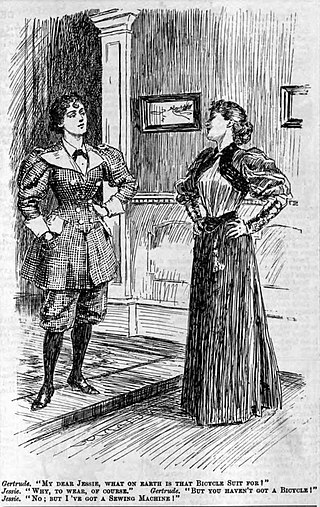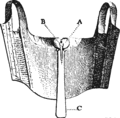
Fashion is a term used interchangeably to describe the creation of clothing, footwear, accessories, cosmetics, and jewellery of different cultural aesthetics and their mix and match into outfits that depict distinctive ways of dressing as signifiers of social status, self-expression, and group belonging. As a multifaceted term, fashion describes an industry, styles, aesthetics, and trends.

A corset is a support garment worn to hold and train the torso into the desired shape and posture. They are traditionally constructed out of fabric with boning made of whalebone or steel, a stiff panel in the front called a busk which holds the torso rigidly upright, and some form of lacing which allows the garment to be tightened. Corsets were an essential undergarment in European women's fashion from the 17th century to the early 20th century. In the 17th and 18th centuries they were commonly known as "stays" and had a more conical shape. This later evolved into the curvaceous 19th century form which is commonly associated with the corset today. By the beginning of the 20th century, shifting gender roles and the onsets of World War I and II led the corset to be largely discarded by mainstream fashion.

Victorian fashion consists of the various fashions and trends in British culture that emerged and developed in the United Kingdom and the British Empire throughout the Victorian era, roughly from the 1830s through the 1890s. The period saw many changes in fashion, including changes in styles, fashion technology and the methods of distribution. Various movement in architecture, literature, and the decorative and visual arts as well as a changing perception of gender roles also influenced fashion.

The corset is a supportive undergarment for women, dating, in Europe, back several centuries, evolving as fashion trends have changed and being known, depending on era and geography, as a pair of bodies, stays and corsets. The appearance of the garment represented a change from people wearing clothes which fit their bodies to changing the shape of their bodies to support and fit their fashionable clothing.

Fashion in the 1890s in Western countries is characterized by long elegant lines, tall collars, and the rise of sportswear. It was an era of great dress reforms led by the invention of the drop-frame safety bicycle, which allowed women the opportunity to ride bicycles more comfortably, and therefore, created the need for appropriate clothing.

A bustle is a padded undergarment or wire frame used to add fullness, or support the drapery, at the back of women's dresses in the mid-to-late 19th century. Bustles are worn under the skirt in the back, just below the waist, to keep the skirt from dragging. Heavy fabric tended to pull the back of a skirt down and flatten it. As a result a woman's petticoated skirt would lose its shape during everyday wear.

Victorian dress reform was an objective of the Victorian dress reform movement of the middle and late Victorian era, led by various reformers who proposed, designed, and wore clothing considered more practical and comfortable than the fashions of the time.

Artistic Dress was a fashion movement in the second half of the nineteenth century that rejected highly structured and heavily trimmed Victorian trends in favour of beautiful materials and simplicity of design. It arguably developed in Britain in the early 1850s, influenced by artistic circles such as the Pre-Raphaelites, and Dress Reform movements. It subsequently developed into more specific categories such as Aesthetic Dress and Künstlerkleid on the continent.

Empire silhouette, Empire line, Empire waist or just Empire is a style in clothing in which the dress has a fitted bodice ending just below the bust, giving a high-waisted appearance, and a gathered skirt which is long and loosely fitting but skims the body rather than being supported by voluminous petticoats. The outline is especially flattering to apple shapes wishing to disguise the stomach area or emphasize the bust. The shape of the dress also helps to lengthen the body's appearance.

An hourglass corset is a garment that produces a silhouette resembling an hourglass shape characterized by wide hips, narrow waist, and wide bust.

Fashion in the period 1795–1820 in European and European-influenced countries saw the final triumph of undress or informal styles over the brocades, lace, periwigs and powder of the earlier 18th century. In the aftermath of the French Revolution, no one wanted to appear to be a member of the French aristocracy, and people began using clothing more as a form of individual expression of the true self than as a pure indication of social status. As a result, the shifts that occurred in fashion at the turn of the 19th century granted the opportunity to present new public identities that also provided insights into their private selves. Katherine Aaslestad indicates how "fashion, embodying new social values, emerged as a key site of confrontation between tradition and change."

Western fashion in the 1920s underwent a modernization. Women's fashion continued to evolve from the restrictions of gender roles and traditional styles of the Victorian era. Women wore looser clothing which revealed more of the arms and legs, that had begun at least a decade prior with the rising of hemlines to the ankle and the movement from the S-bend corset to the columnar silhouette of the 1910s. Men also began to wear less formal daily attire and athletic clothing or 'Sportswear' became a part of mainstream fashion for the first time.

Fashion in the period 1900–1909 in the Western world continued the severe, long and elegant lines of the late 1890s. Tall, stiff collars characterize the period, as do women's broad hats and full "Gibson Girl" hairstyles. A new, columnar silhouette introduced by the couturiers of Paris late in the decade signaled the approaching abandonment of the corset as an indispensable garment.

Steampunk fashion is a subgenre of the steampunk movement in science fiction. It is a mixture of the Victorian era's romantic view of science in literature and elements from the Industrial Revolution in Europe during the 1800s. Steampunk fashion consists of clothing, hairstyling, jewellery, body modification and make-up. More modern ideals of steampunk can include t-shirts with a variety of designs or the humble jeans being accessorised with belts and gun holsters.
Ellen Mirojnick is an American costume designer. She is a frequent collaborator of actor Michael Douglas, having overseen the costume design for the films Fatal Attraction (1987), Wall Street (1987), Basic Instinct (1992), A Perfect Murder (1998), Wall Street: Money Never Sleeps (2010) and Behind the Candelabra (2013). The wardrobe which she created for the character of Gordon Gekko inspired a fashion trend in the late 1980s and early 1990s for boldly patterned ties, sleek suits, crisp white shirts, and colorful suspenders in men's business wear. She has also been a frequent collaborator of directors Jan de Bont and Paul Verhoeven, acting as costume designer on de Bont's films Speed (1994), Twister (1996) and The Haunting (1999), as well as Verhoeven's films Basic Instinct (1992), Showgirls (1995), Starship Troopers (1997) and Hollow Man (2000).

Virginie Viard is a French fashion designer who was the creative director of Chanel from 2019 to 2024.

The fashions of the 2020s represent a departure from 2010s fashion and feature a nostalgia for older aesthetics. They have been largely inspired by styles of the late 1990s to mid-2000s, and 1980s. Early in the decade, several publications noted the shortened trend and nostalgia cycle in 2020s fashion. Fashion was also shaped by the COVID-19 pandemic, which had a major impact on the fashion industry, and led to shifting retail and consumer trends.
Ines Di Santo is an Italian-Argentine designer of bridal and eveningwear couture.

Coquette aesthetic is a 2020s fashion trend that is characterized by a mix of sweet, romantic, and sometimes playful elements and focuses on femininity through the use of clothes with lace, flounces, pastel colors, and bows, often draws inspiration from historical periods like the Victorian era and the 1950s, with a modern twist.
Cassidy Percoco is an American fashion historian and collections manager.



















